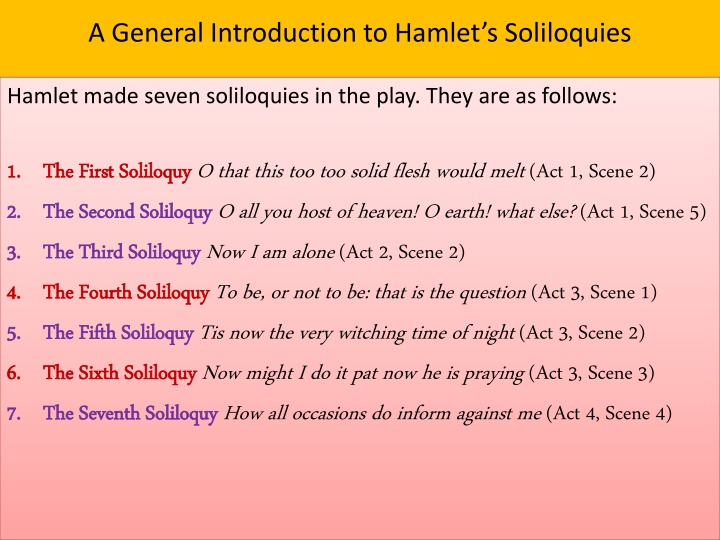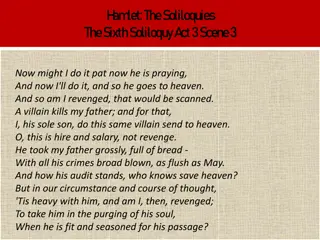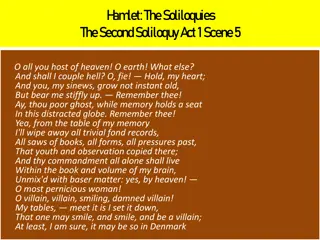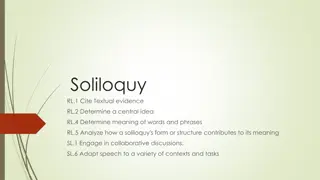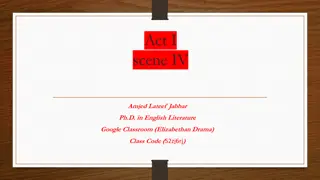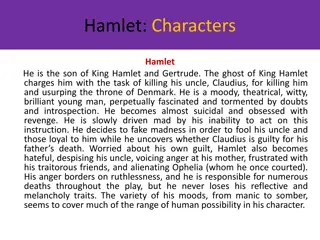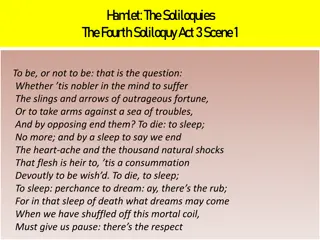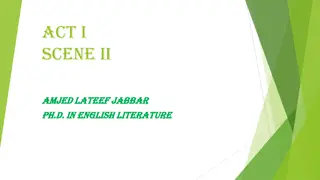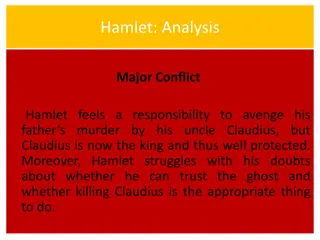Analysis of Hamlet's Soliloquies
Hamlet's seven soliloquies in the play reveal his complex inner thoughts and emotions. Divided into two groups, the soliloquies showcase Hamlet's contemplation of life, death, morality, and existential questions. The first group reflects Hamlet's passive and reflective nature, while the second group demonstrates his moments of intense emotion and action. Each soliloquy provides insight into Hamlet's character and struggles as he navigates the challenges and conflicts in his world.
Uploaded on Feb 19, 2025 | 0 Views
Download Presentation

Please find below an Image/Link to download the presentation.
The content on the website is provided AS IS for your information and personal use only. It may not be sold, licensed, or shared on other websites without obtaining consent from the author.If you encounter any issues during the download, it is possible that the publisher has removed the file from their server.
You are allowed to download the files provided on this website for personal or commercial use, subject to the condition that they are used lawfully. All files are the property of their respective owners.
The content on the website is provided AS IS for your information and personal use only. It may not be sold, licensed, or shared on other websites without obtaining consent from the author.
E N D
Presentation Transcript
A General Introduction to Hamlets Soliloquies Hamlet made seven soliloquies in the play. They are as follows: 1. 1. The 2. 2. The Second Soliloquy The Second Soliloquy O all you host of heaven! O earth! what else? (Act 1, Scene 5) 3. 3. The Third Soliloquy The Third SoliloquyNow I am alone (Act 2, Scene 2) 4. 4. The Fourth Soliloquy The Fourth Soliloquy To be, or not to be: that is the question (Act 3, Scene 1) 5. 5. The Fifth Soliloquy The Fifth Soliloquy Tis now the very witching time of night(Act 3, Scene 2) 6. 6. The Sixth The Sixth Soliloquy Soliloquy Now might I do it pat now he is praying (Act 3, Scene 3) 7. 7. The Seventh Soliloquy The Seventh SoliloquyHow all occasions do inform against me (Act 4, Scene 4) The First First Soliloquy SoliloquyO that this too too solid flesh would melt (Act 1, Scene 2)
A General Introduction to Hamlets Soliloquies These seven soliloquies can be divided into two groups. The first group includes the following soliloquies: 1. The first soliloquy. 2. The fourth soliloquy. 3. The sixth soliloquy.
A General Introduction to Hamlets Soliloquies The second group includes the following soliloquies: 1. 2. The third soliloquy. 3. The fifth soliloquy. 4. The seventh soliloquy. The second soliloquy.
A General Introduction to Hamlets Soliloquies The first group of soliloquies show the Hamlet inactive and over- reflective, inclined to toy with the idea of suicide, to overlook the responsibilities of life, and speculate in an unhealthy manner on existence beyond the grave. Indeed, the fourth soliloquy-the famous "To be or not to be "-marks the lowest intellectual level reached by Hamlet. All of them are the product of a relatively passive frame of mind. The first is uttered before Hamlet has learned of his father's murder; the fourth is spoken in the quiet of the morning before the play; while in the sixth, though the presence of Claudius disturbs Hamlet's conscience, the motionless and suppliant posture of the King evidently acts as a check on the speaker's emotions.
A General Introduction to Hamlets Soliloquies The second group shows Hamlet in far more normal and admirable moods, and each of these soliloquies is produced by a state of special excitement. The second immediately follows the exit of the Ghost, the third is inspired by the Player's moving declamation, the fifth follows the success of the "Mousetrap," and the seventh is evoked by the impressive sight of Fortinbras and his army
The End See you next time!
